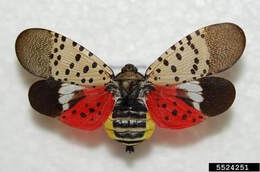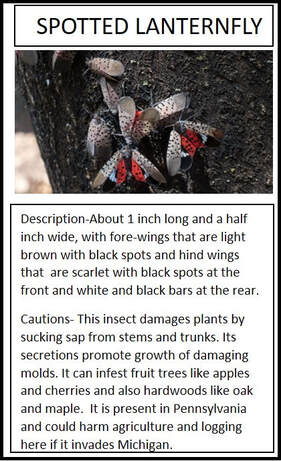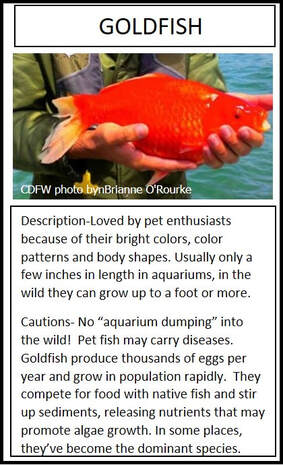
FBI: Fighting Bad Invasives
By Jessica Wagonmaker and Jessica Vander Ark
Holton Public Schools and GVSU College of Education
CLICK ON IMAGE TO DOWNLOAD A PRINTABLE VERSION OF THIS LESSON PLAN
We would greatly appreciate your feedback! Click here to complete a short survey telling us about your experience with this lesson plan.
By Jessica Wagonmaker and Jessica Vander Ark
Holton Public Schools and GVSU College of Education
CLICK ON IMAGE TO DOWNLOAD A PRINTABLE VERSION OF THIS LESSON PLAN
We would greatly appreciate your feedback! Click here to complete a short survey telling us about your experience with this lesson plan.
Lesson overview
In this lesson students will sort invasive species cards in order to categorize them by most dangerous to the environment to least dangerous. Students can also elaborate on the basic lesson by proposing ways of controlling, eradicating, or preventing invasive species.
Target grade: 6th -9th grade
Lesson Objectives
At the end of this lesson, student will be able to:
Source Material
General information about many actual and potential invasive species in the Midwest: https://www.misin.msu.edu/
Additional information about spotted lanternfly: https://www.usnews.com/news/best-states/pennsylvania/articles/2019-04-21/michigan-experts-warn-residents-about-spotted-lanternflies
Additional information about goldfish: https://www.nytimes.com/2016/09/23/science/discarded-goldfish-invasive-species.html
Michigan Science Standards
● MS-LS2-4 Ecosystems: Interactions, Energy and Dynamics. Construct an argument supported by empirical evidence that changes to physical or biological components of an ecosystem affect populations.
● MS-LS2-2 Ecosystems: Interactions, Energy and Dynamics. Construct an explanation that predicts patterns of interactions among organisms across multiple ecosystems.
List of Materials
Per group of students:
1 set of Ten Most Wanted Aquatic Cards
European Frogbit, Asian Carp, Northern Snakehead, Zebra Mussels, Water Milfoil, Phragmites, Red Swamp Crayfish, Purple Loosestrife, Quagga Mussel, Sea Lamprey
1 set of Ten Most Wanted Terrestrial Cards
Autumn Olive, Garlic Mustard, Spotted Knapweed, Mute Swan, Asian Longhorned Beetle, Gypsy Moth, Emerald Ash Borer, Japanese Beetle, Feral Swine, Common Buckthorn
Engage examples: Aquatic invasive—Goldfish
Terrestrial example—Spotted lanternfly
Depending on the number of students, you may decide if the class should do only the aquatic invasive species, the terrestrial invasive species, or both.
FBI-Fighting Bad Invasives worksheet
Focus Question: Which (aquatic or terrestrial) invasive species is the most dangerous to the environment?
5E Lesson Plan
Engage
Teacher shows a picture and presents information about either an aquatic invasive species (e.g., goldfish) or terrestrial invasive species (e.g., spotted lanternfly), as a way of introducing and defining the concept of invasive species and generating a discussion of how an invasive species might be harmful. These two examples are not part of the Ten Most Wanted cards but are ones that students might encounter. They might think about them when they are doing their Ten Most Wanted rankings. Here are “cards” on goldfish and the spotted lanternfly that are similar to the ones used in the Ten Most Wanted activity:
In this lesson students will sort invasive species cards in order to categorize them by most dangerous to the environment to least dangerous. Students can also elaborate on the basic lesson by proposing ways of controlling, eradicating, or preventing invasive species.
Target grade: 6th -9th grade
Lesson Objectives
At the end of this lesson, student will be able to:
- Categorize invasive species based on their descriptions and cautions.
- Justify their reasons for rankings with convincing arguments.
Source Material
General information about many actual and potential invasive species in the Midwest: https://www.misin.msu.edu/
Additional information about spotted lanternfly: https://www.usnews.com/news/best-states/pennsylvania/articles/2019-04-21/michigan-experts-warn-residents-about-spotted-lanternflies
Additional information about goldfish: https://www.nytimes.com/2016/09/23/science/discarded-goldfish-invasive-species.html
Michigan Science Standards
● MS-LS2-4 Ecosystems: Interactions, Energy and Dynamics. Construct an argument supported by empirical evidence that changes to physical or biological components of an ecosystem affect populations.
● MS-LS2-2 Ecosystems: Interactions, Energy and Dynamics. Construct an explanation that predicts patterns of interactions among organisms across multiple ecosystems.
List of Materials
Per group of students:
1 set of Ten Most Wanted Aquatic Cards
European Frogbit, Asian Carp, Northern Snakehead, Zebra Mussels, Water Milfoil, Phragmites, Red Swamp Crayfish, Purple Loosestrife, Quagga Mussel, Sea Lamprey
1 set of Ten Most Wanted Terrestrial Cards
Autumn Olive, Garlic Mustard, Spotted Knapweed, Mute Swan, Asian Longhorned Beetle, Gypsy Moth, Emerald Ash Borer, Japanese Beetle, Feral Swine, Common Buckthorn
Engage examples: Aquatic invasive—Goldfish
Terrestrial example—Spotted lanternfly
Depending on the number of students, you may decide if the class should do only the aquatic invasive species, the terrestrial invasive species, or both.
FBI-Fighting Bad Invasives worksheet
Focus Question: Which (aquatic or terrestrial) invasive species is the most dangerous to the environment?
5E Lesson Plan
Engage
Teacher shows a picture and presents information about either an aquatic invasive species (e.g., goldfish) or terrestrial invasive species (e.g., spotted lanternfly), as a way of introducing and defining the concept of invasive species and generating a discussion of how an invasive species might be harmful. These two examples are not part of the Ten Most Wanted cards but are ones that students might encounter. They might think about them when they are doing their Ten Most Wanted rankings. Here are “cards” on goldfish and the spotted lanternfly that are similar to the ones used in the Ten Most Wanted activity:
Explore
For each species, the group needs to write a justification using: Claim, Evidence, Reasoning to explain their choice of rank.
After writing out their rankings and reasoning, the groups of students will explain their findings to the class.
Elaborate
Ask: How will students find or prevent their “Most wanted” invasives in Michigan? For the written assignment, upper grade students should use the individual ranking sheets which have the additional requirement of including ‘a plan for control, mitigation, eradication and prevention.’
Evaluate
Assessment of student learning will be done by evaluating their justification for each ranking on their worksheet and in their presentations.
- Organize students into groups of 3-4 students. Pass out one set of Ten Most Wanted cards. Instruct students to rank each invasive species according to which is most dangerous to the environment, with 1 = most dangerous, and 10 = least dangerous.
- Student groups will discuss the various invasive species and then fill out the FBI 10 Most Wanted worksheet placing each invasive in the chosen order by evaluating the description and cautions.
For each species, the group needs to write a justification using: Claim, Evidence, Reasoning to explain their choice of rank.
After writing out their rankings and reasoning, the groups of students will explain their findings to the class.
Elaborate
Ask: How will students find or prevent their “Most wanted” invasives in Michigan? For the written assignment, upper grade students should use the individual ranking sheets which have the additional requirement of including ‘a plan for control, mitigation, eradication and prevention.’
Evaluate
Assessment of student learning will be done by evaluating their justification for each ranking on their worksheet and in their presentations.

New lesson plan ideas are welcome and will be uploaded as they are received and approved.
Instructions for submitting lesson plans for:
About invasive species,
About science and science careers
For information about submitting new lesson plans, please contact jchadde(at)mtu.edu
Lesson plan ideas from other web sites:
From Pennsylvania Sea Grant: 10 lesson plans about interactions of invasive species, biodiversity, and climate change
Creation of the above page of educational resources was funded in part by the Michigan Invasive Species Grant Program through the Departments of Natural Resources, Environmental Quality, and Agricultural and Rural Development.
This material is also based upon work supported by the National Science Foundation under Grant No. 1614187.
Any opinions, findings, and conclusions or recommendations expressed in this material are those of the authors and do not necessarily reflect the views of the National Science Foundation.

